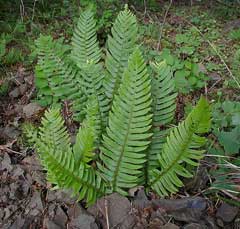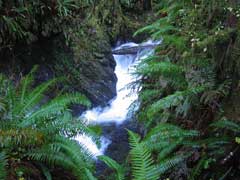 |
|
http://flickr.com/photos/jamidwyer |
 |
| http://flickr.com/photos/41894142129@N01 Tom Harpel |
Translate this page:
Summary
Physical Characteristics

 Polystichum munitum is an evergreen Fern growing to 1 m (3ft 3in) by 0.3 m (1ft).
Polystichum munitum is an evergreen Fern growing to 1 m (3ft 3in) by 0.3 m (1ft).
See above for USDA hardiness. It is hardy to UK zone 4. It is in leaf all year.
Suitable for: light (sandy) and medium (loamy) soils. Suitable pH: mildly acid, neutral and basic (mildly alkaline) soils. It can grow in full shade (deep woodland) or semi-shade (light woodland). It prefers dry or moist soil.
UK Hardiness Map
US Hardiness Map
Synonyms
Aspidium munitum.
Plant Habitats
Woodland Garden Dappled Shade; Shady Edge; not Deep Shade; Ground Cover;
Edible Uses
Edible Parts: Root
Edible Uses:
Root - roasted[2, 105, 118, 161]. Peeled and then baked like potatoes[213]. The roots were generally viewed by the native North American Indians mainly as a famine food for use when little else was available[256]. The roots were generally harvested in the spring, before the plant came into growth then cooked and peeled before being eaten[256].
References More on Edible Uses
Medicinal Uses
Plants For A Future can not take any responsibility for any adverse effects from the use of plants. Always seek advice from a professional before using a plant medicinally.
Antidandruff Birthing aid Poultice
An infusion of the fronds has been used as a wash or poultice to treat boils and sores[213, 257]. The young shoots have been chewed and eaten as a treatment for cancer of the womb and to treat sore throats and tonsillitis[257]. The leaves have been chewed by women to facilitate childbirth[257]. The sporangia have been crushed and applied as a poultice to burns, sores and boils[213, 257]. A decoction of the rhizomes has been used in the treatment of dandruff[213, 257].
References More on Medicinal Uses
The Bookshop: Edible Plant Books
Our Latest books on Perennial Plants For Food Forests and Permaculture Gardens in paperback or digital formats.

Edible Tropical Plants
Food Forest Plants for Hotter Conditions: 250+ Plants For Tropical Food Forests & Permaculture Gardens.
More

Edible Temperate Plants
Plants for Your Food Forest: 500 Plants for Temperate Food Forests & Permaculture Gardens.
More

More Books
PFAF have eight books available in paperback and digital formats. Browse the shop for more information.
Shop Now
Other Uses
Hair Lining
The leaves are used for lining boxes, baskets, fruit drying racks etc and as a stuffing material in bedding[99, 118, 257]. A decoction of the rhizome treats dandruff[172]. Plants can be grown as a ground cover and are best spaced about 1 metre apart each way[208].
Special Uses
Ground cover
References More on Other Uses
Cultivation details
Very hardy and easily grown in light shade in any reasonable soil[187]. Prefers a sandy humus-rich soil in a shady position that is moist even in winter[1]. Tolerates part sun for up to 6 hours a day if the soil remains moist[200]. It is possible that the var. imbricans will succeed in drier soils[K]. Prefers a pH in the range 6.5 to 7.5[200]. Members of this genus are rarely if ever troubled by browsing deer[233]. A very ornamental plant[1], it is a robust clump-forming species[187]. Remove old fronds from the plant in the spring because they may harbour fungal diseases[200].
References Carbon Farming Information and Carbon Sequestration Information
Temperature Converter
Type a value in the Celsius field to convert the value to Fahrenheit:
Fahrenheit:
The PFAF Bookshop
Plants For A Future have a number of books available in paperback and digital form. Book titles include Edible Plants, Edible Perennials, Edible Trees,Edible Shrubs, Woodland Gardening, and Temperate Food Forest Plants. Our new book is Food Forest Plants For Hotter Conditions (Tropical and Sub-Tropical).
Shop Now
Plant Propagation
Spores - best sown as soon as they are ripe, though they can also be sown in the spring. Sow them on the surface of a humus-rich sterilized soil. Keep the compost moist, preferably by putting a plastic bag over the pot. Pot on small clumps of plantlets as soon as they are large enough to handle and keep humid until they are well established. Do not plant outside until the ferns are at least 2 years old and then only in a very well sheltered position. Division. This is best done in the spring.
Other Names
If available other names are mentioned here
Native Range
NORTHERN AMERICA: Canada (Yukon, British Columbia), United States (Alaska, South Dakota, Idaho, Montana, Oregon, Washington, California, Baja California (Norte) (Guadalupe Island))
Weed Potential
Right plant wrong place. We are currently updating this section.
Please note that a plant may be invasive in one area but may not in your area so it's worth checking.
Conservation Status
IUCN Red List of Threatened Plants Status :

Growth: S = slow M = medium F = fast. Soil: L = light (sandy) M = medium H = heavy (clay). pH: A = acid N = neutral B = basic (alkaline). Shade: F = full shade S = semi-shade N = no shade. Moisture: D = dry M = Moist We = wet Wa = water.
Now available:
Food Forest Plants for Mediterranean Conditions
350+ Perennial Plants For Mediterranean and Drier Food Forests and Permaculture Gardens.
[Paperback and eBook]
This is the third in Plants For A Future's series of plant guides for food forests tailored to
specific climate zones. Following volumes on temperate and tropical ecosystems, this book focuses
on species suited to Mediterranean conditions—regions with hot, dry summers and cool, wet winters,
often facing the added challenge of climate change.
Read More
Expert comment
Author
(Kaulfuss.)C.Presl.
Botanical References
60200
Links / References
For a list of references used on this page please go here
Readers comment
| Add a comment |
|
If you have important information about this plant that may help other users please add a comment or link below. Only comments or links that are felt to be directly relevant to a plant will be included. If you think a comment/link or information contained on this page is inaccurate or misleading we would welcome your feedback at [email protected]. If you have questions about a plant please use the Forum on this website as we do not have the resources to answer questions ourselves.
* Please note: the comments by website users are not necessarily those held by PFAF and may give misleading or inaccurate information.
To leave a comment please Register or login here All comments need to be approved so will not appear immediately.
|
Subject : Polystichum munitum
|
|
|
|